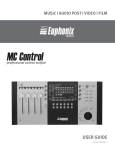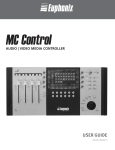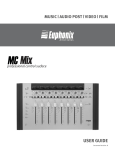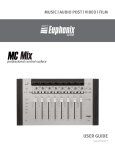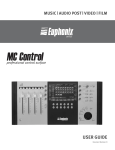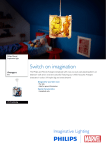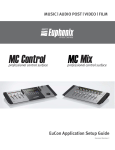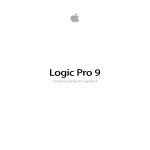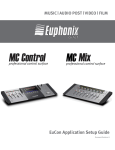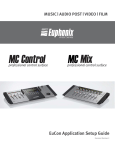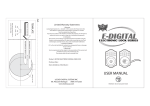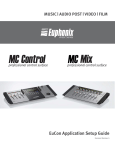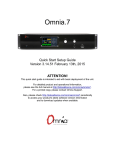Download Euphonix Artist Series MC
Transcript
REVIEW Euphonix Artist Series MC Extremely well-received when they first appeared for presenting a good mix of control in a well-presented package, the MC Control and MC Mix offer Eucon and other control to the masses. ROB JAMES finds that his high expectations are largely met. H ardware controllers for software applications have been with us for a number of years and, in the DAW arena, Mackie’s HUI can lay a reasonable claim to having been the first successful design. Its control protocol and the later Mackie Control protocol are the nearest the industry has come to establishing universal standards in this area. Meanwhile, Euphonix has garnered a reputation at the high end with its Series 5 console and also laid the foundations for another control protocol standard, EuCon. The highend controller product is the impressive System 5 MC but now Euphonix has released two much more affordable controllers as the Artist series. First to arrive was the (UK £747 + VAT) MC Mix, an eight fader mix controller. More recently this has been joined by the (UK £1078 + VAT) MC Control, which combines a ‘centre section’ with transport controls and four faders. Up to five units can be used together — four MC Mix and an MC Control. Units can be left free-standing or physically joined after removing the side cheeks. A variety of operating heights and angles can be achieved by using four flip out feet, similar to those found on PC keyboards, or by adding rather insubstantial plastic risers. Ethernet is used to connect the Artist series to the DAW(s). Each unit needs a separate port so an Ethernet switch or router will be required for a multi-unit system. Ethernet confers many advantages when compared with the more common MIDI connection, principally cheap and easy connection, speed and resolution. Physically, the units are svelte and very handsome. They feel solid thanks to the heavy sheet steel base. 22 Power supplies are external in-line bricks. Before MC Control or MC Mix can be used the EuControl software application must be installed. This locates, links and communicates with all the Artist/Eucon control devices on the network. Once installed, the application(s) you wish to use must be dragged into a section of the EuControl window and the applications themselves must be set up to accept EuCon control. The procedure varies between apps and is well detailed in the on-line manuals. Only one instance of EuControl can run per Mac, but multiple workstations attached to a single network can each run EuControl. Each instance of EuControl can connect to an MC Control and up to four MC Mixes on the network. The devices then act together as a single control surface. Once connected to a workstation, devices are not available to any other instances of EuControl until they are released. An Artist device can also control applications running on a second computer. Any workstation running EuCon software can be in this list, including those controlled by the System 5-MC, MC Pro, and MC Control although the Artist Series is only supported currently for Mac-based applications. MC Control — MC Control can use several control protocols, so-called EuCon-aware applications (e.g. Nuendo, Cubase, Digital Performer, Logic Pro) support the EuCon protocol directly with specially written software. This can provide the most comprehensive integration plus high-resolution controls and high-speed connectivity. Applications that are not EuCon-aware applications but which support the Mackie Control or HUI protocols (e.g. Pro resolution Tools, Final Cut Pro) can also benefit from control of many functions. MC Control can also transmit key commands over EuCon providing a degree of control over many other applications and adding to the functionality in EuCon and Mackie Control/HUI aware software. Centrepiece of the MC Control is a large LCD wide touchscreen — the viewing angle encourages you to tilt the unit towards you a little. Four touch-sensitive ‘Soft Knobs’ with top switches range on either side and two rows of six Soft Keys are underneath along with Soft Key paging buttons. The Soft Knobs give access to a hierarchical menu system. The top-level ‘knobset’ offers the choice of eight functions to be controlled by the Soft Knobs. At the bottom of the Touchscreen two rows of six Soft Key labels correspond to the physical Soft Keys. At first I kept pressing the labels on screen but I’m obviously not the only one since a helpful message appears telling you to use the buttons… Most of the other keys have Shifted functions. Labels on the surface are not very clear but you soon learn where everything is. The Shift keys are at bottom left and bottom right and pressing both together latches into Shift mode. In the fader section four identical strips contain Solo and On buttons, a motorised touch fader and Record and Select buttons — Automation and Assign respectively when shifted. Holding down the Shift key and touching a fader sets it to unity gain. To the right of the Touchscreen the Control Room (monitor) volume knob and Power button sit above the Navigation section. The knob controls either the included Studio Monitor Express software or an application that supports a EuCon monitor section. Pressing the knob toggles mute. The top two of the eight navigation keys are Back (Top) and Application (Workspace). Back steps back up the tree of knob sets and closes the plug-in. Application toggles between the two most recently used open apps and Top goes directly to the top level while Workstation switches between controlled Macs when more than one is April 2009 REVIEW set up to be controlled. Page keys move between parameter pages in plug-ins. Like most controllers, the four faders are a window looking at a much bigger console. This window can be moved one strip at a time with Nudge keys or four strips at a time with the Bank keys. Shifted, the Bank keys move the window to the far left (home) or right (end) of the mixer. Nudge Left Shifted toggles the Mixer window and Nudge Right closes any open window or dialog. In the most logical place bottom-right, at least for right-handers, the Transport controls are arranged in an arc around the Jog/Shuttle wheel. Record is sensibly offset on the right. The leftmost two are jog/ shuttle and Zoom Horizontal (Vertical). In operation the MC Control is much more intuitive than most other controllers and also manages to be a lot more comprehensive. The Touchscreen is a big help in this. For example in Tracks View you can see 32 tracks at a time for rapid muting, soloing, record arming and selecting tracks that are not assigned to faders. You simply select the desired operation on one of the round circular buttons on the left and then touch one or more square track buttons to execute the operation on the selected tracks. MC Mix — Although similar in appearance and April 2009 complementary in function to the MC Control, MC Mix differs in some significant ways. The eight fader strips gain extra On and Select buttons at the top and a touch-sensitive knob with switch. Navigation is pretty much the same but with the addition of a Channel (Flip) key. Chan enters Channel mode where all displays and controls now relate to the ‘attentioned’ strip -– for example, pressing Inserts spreads all the plug-ins in the selected strip across the 128 x 74 pixel OLED displays. Pressing one of the knobs then brings up all parameters of that plug-in across all the strips. If there are more parameters than strips then you can page through them. The Flip key swaps parameters between the faders and knobs. Knobs sometimes have dual functions, for example, frequency and Q, using the top switch to toggle. The OLED displays do a good job of keeping you informed throughout operation. Transport control can be had by using Shift with the last four strips’ Solo and On buttons. Not ideal but useful. MC-Mix is much more ‘conventional’ than the MC Control. I used the Artist series units with Final Cut Pro and Soundtrack Pro. Pages of properly labelled keyboard shortcuts are a real productivity aid and transformed the way I previously felt about FCP. (I can resolution never remember any but the most obvious keyboard shortcuts due to the number of applications I use.) Just as impressive is switching between applications. Literally at the touch of a button you can jump from one to the other and the control surface updates instantly to reflect this. The software and firmware is still developing so it is important to check for updates. Installing these is trivial. After updating you should also check if the firmware needs updating from within the EuControl software. If an update is required the process is virtually automatic. I’m surprised the Artist series can only control Mac applications. There are an awful lot of us using PCs for very serious work and Euphonix is missing out (MC Pro is the PC-oriented controller according to Euphonix. Ed). MC Control is a flawed masterpiece. The software, design and functional concepts are excellent. Despite the splendid Touchscreen, the tactile user interface is marred by rubbery and imprecise buttons. This is of little consequence for most functions but it is important for the transport controls. The jog/shuttle wheel is just horrible. The user manual talks gaily about ‘spinning the jog wheel’. Well, I don’t know what unit they were using but on the one I had and the previous one I played with at a trade show the jog wheel was lightweight, flimsy, stiff and graunchy and spinning it just isn’t an option. I would happily pay a few pounds more for a better jog wheel and transport buttons. Touchscreen refresh rate seems a little low. On the other hand, MC Mix can be recommended pretty much unequivocally. The price is right and it does rather more than you would expect at first glance. I had very high expectations of these units and, in terms of feature sets and well thought out user interface layouts, they do not disappoint. n PROS Excellent concept and interface layout; seamless control over multiple applications; intuitive as controllers go. CONS MC Control jogwheel is dire; transport buttons a bit rubbery; touchscreen flicker. Contact euphonix, US: Website: www.euphonix.com 23


